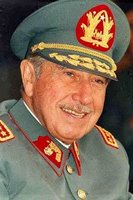Christmas... is it?
So, it is December. Christmas' month. Santa's time. Big fat guy on a red suit, ringing his bell and flying around on his sleigh. It is, indeed, a nice picture. He must find himself warm under those heavy clothes.
Down here, it is Christmas too, but it is summer and we got the lots of guys sweating underneath those red fabrics. And we got sleighs but no snow. You may also see some Christmas trees decorated with fake foamy snow.
I just do not understand that.
I would rather have a nice warm-style Christmas. Cold dishes for dinner. Getting flip flops and snorkels. I want some Christmas' Old Fellows (that would be the literal translation of how we call that guy here: Viejo Pascuero) wearing shorts and shaved, riding anything that could move on anything that is not snow -a pick-up truck maybe or a carriage if you prefer something more traditional-, and a red cap instead of that impotent pointy hat, although we could keep the white cotton ball on top of it. I just want a summer Santa Claus.
But I believe everyone should have his or her own holyday.
Which one is yours? How it is going to be? How was it?
How is it in Prague? in Berlin? in Hawthrone? in Albany? in Richland? in Bahrain? in Paris? in Tegucigalpa? in Leeds? in Schenectady? in Bogotá? in Québec? in Trinidad? in London? in Barcelona? in Kyoto? in Lagos? in NYC? in Portland? in Rennes? in Buenos Aires? in El Paso? in WDC? in Tokio? in Fiji? Where ever you are... how is it?
Down here, it is Christmas too, but it is summer and we got the lots of guys sweating underneath those red fabrics. And we got sleighs but no snow. You may also see some Christmas trees decorated with fake foamy snow.
I just do not understand that.
I would rather have a nice warm-style Christmas. Cold dishes for dinner. Getting flip flops and snorkels. I want some Christmas' Old Fellows (that would be the literal translation of how we call that guy here: Viejo Pascuero) wearing shorts and shaved, riding anything that could move on anything that is not snow -a pick-up truck maybe or a carriage if you prefer something more traditional-, and a red cap instead of that impotent pointy hat, although we could keep the white cotton ball on top of it. I just want a summer Santa Claus.
But I believe everyone should have his or her own holyday.
Which one is yours? How it is going to be? How was it?
How is it in Prague? in Berlin? in Hawthrone? in Albany? in Richland? in Bahrain? in Paris? in Tegucigalpa? in Leeds? in Schenectady? in Bogotá? in Québec? in Trinidad? in London? in Barcelona? in Kyoto? in Lagos? in NYC? in Portland? in Rennes? in Buenos Aires? in El Paso? in WDC? in Tokio? in Fiji? Where ever you are... how is it?

 There is no much more to say about Pinochet's death this afternoon that you might have already read.
There is no much more to say about Pinochet's death this afternoon that you might have already read. Remember when Jimmy Carter said that he'd like to start each government department with a zero-based budget and then have them prove they needed any money at all? He never got very far with that and I probably won't get very far with what I am about to suggest either:
Remember when Jimmy Carter said that he'd like to start each government department with a zero-based budget and then have them prove they needed any money at all? He never got very far with that and I probably won't get very far with what I am about to suggest either: 







